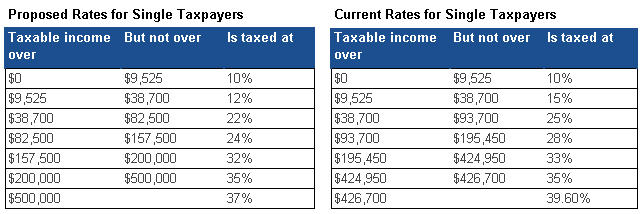Key Provisions of the Tax Cuts and Jobs Act of 2017 for Individuals

On Friday, December 15, the final version of the Tax Cuts and Jobs Act of 2017 was released along with the Conference Committee notes. This version was a result of the reconciliation between the House and Senate versions of the bill that were released over the past several weeks. Given the high probability of passage of the bill and ultimate signature of the President, we felt it prudent to lay out some of the key features and tax law provisions affecting individuals.
It is important to still view these items as tax proposals as opposed to tax laws. Also, many of the tax provisions affecting individuals have a sunset provision where the particular rule will revert back to the current law in 2025.
Tax Rates
- For tax years 2018 through 2025, individuals will continue to have seven brackets, with the highest marginal tax rate of 37%.
Standard Deduction and Personal Exemptions
- The standard deduction is set to increase to $12,000 for individuals and $24,000 for married couples filing jointly. Under current law, the standard deduction for individuals is $6,500 and $13,000 for married couples filing jointly.
- The personal exemptions would be repealed. Under current law, some taxpayers lost the exemptions due to income level phase-outs.
- The net of the higher standard deduction and lower personal exemptions depends on the number of exemptions one takes each year. Couples filing jointly with more than one child will have a lower standard deduction than the combined old standard deduction and personal exemptions.
Capital Gains and Qualified Dividends Rates
- The capital gains and qualified dividend tax rates remained unchanged at 0%, 15%, and 20%.
- The income thresholds for each of the rates also remained unchanged and do not correspond to the tax brackets, as they have in the past.
Child Tax Credit
- The child tax credit increases to $2,000 per child (of which $1,400 is a refundable credit).
- The income phase-outs for the credit are dramatically increased from $75,000 for individuals and $110,000 for married filing joint couples to $200,000 and $400,000, respectively. This results in tax savings, even when you offset it by the loss of personal exemptions.
- A new $500 qualifying dependent credit has been added for dependents over age 17, including dependent parents.
State & Local Income, Sales & Property Taxes
- The itemized deduction for State & Local Income, Sales and Property taxes is capped at $10,000 on the combined total.
Mortgage Interest and Home Equity Indebtedness
- Mortgage interest related to acquisition indebtedness is deductible up to $750,000 of principal.
- Interest paid in relation to a home equity loan or home equity line of credit not used for acquisition indebtedness is non-deductible.
Miscellaneous Itemized Deductions
- Miscellaneous itemized deductions are repealed, including no deductions related to tax preparation fees, attorney fees or investment advisory fees.
Cash Charitable Contributions to a Public Charity
- The limit for the deduction of cash charitable contributions to a public charity was increased from 50% of AGI to 60% of AGI.
- There is no change in the deduction limits for non-cash contributions, such as appreciated securities.
- No charitable contribution deduction is allowed for purchase of event seating rights.
Alternative Minimum Tax (AMT)
- Alternative Minimum Tax for individuals remains intact, but with higher exemption amounts and much higher phase-out amounts.
- With the greater exemptions, higher phase-outs, and reduced itemized deductions to add back, far fewer taxpayers are projected to be subject to AMT in the future.
529 Plans
- 529 distributions can now be used tax-free for private elementary and secondary school expenses for up to $10,000 per student per year. This includes public, private, and religious schools.
Kiddie Tax
- Unearned income of a child will be taxed under the trust tax brackets as opposed to being added to the parent’s income and taxed at the parent’s rate.
Alimony
- Alimony payments are no longer deductible by payers, nor reportable by recipients as income.
- This provision will only apply to divorce agreements after December 31, 2018.
Pass-through Entity Qualified Business Income Deduction
- 20% deduction for Qualified Business Income, which excludes investment income and income from service businesses.
- There are specific rules regarding reasonable compensation, as well as specific provisions favorable for real estate businesses.
Estate & Gift Exemptions
- The Estate & Gift Exemptions will double to $11.2M for an individual and $22.4M for a married couple with portability.
- Top rate remains at 40% and the step-up in basis also remains.
Items that did not change
- Student loan interest is still deductible.
- Sale of Principal Residence rules remain the same: Exclude $250,000 for singles ($500,000 for married couples) if you used the property as your primary residence for 2 of the last 5 years.
- Deduction for contributions to a 401(k) remains.
- Specific identification for sales of securities is still allowed. The FIFO proposal did not pass.
Beyond the above list of key individual provisions, there are many more. Each client’s situation is different. Your Bartlett wealth advisor can help you consider your tax situation, alongside your other advisors, to determine how these changes affect you and your family.
The above commentary represents the opinion of the author as of December 18, 2017, and is subject to change at any time due to market or economic conditions or other factors. This information is not intended to serve as tax or legal advice. As always, tax and legal counsel should be engaged before taking any action. Bartlett does not provide legal or tax compliance services.



